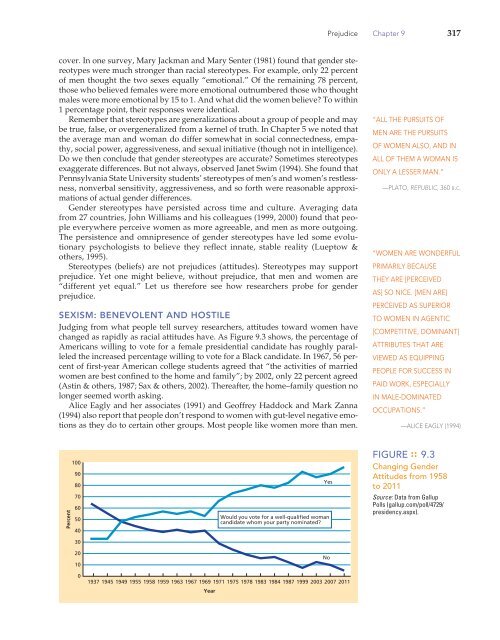Chapter 9: Prejudice: Disliking Others (2947.0K) - Bad Request
Chapter 9: Prejudice: Disliking Others (2947.0K) - Bad Request
Chapter 9: Prejudice: Disliking Others (2947.0K) - Bad Request
Create successful ePaper yourself
Turn your PDF publications into a flip-book with our unique Google optimized e-Paper software.
cover. In one survey, Mary Jackman and Mary Senter (1981) found that gender stereotypes<br />
were much stronger than racial stereotypes. For example, only 22 percent<br />
of men thought the two sexes equally “emotional.” Of the remaining 78 percent,<br />
those who believed females were more emotional outnumbered those who thought<br />
males were more emotional by 15 to 1. And what did the women believe? To within<br />
1 percentage point, their responses were identical.<br />
Remember that stereotypes are generalizations about a group of people and may<br />
be true, false, or overgeneralized from a kernel of truth. In <strong>Chapter</strong> 5 we noted that<br />
the average man and woman do differ somewhat in social connectedness, empathy,<br />
social power, aggressiveness, and sexual initiative (though not in intelligence).<br />
Do we then conclude that gender stereotypes are accurate? Sometimes stereotypes<br />
exaggerate differences. But not always, observed Janet Swim (1994). She found that<br />
Pennsylvania State University students’ stereotypes of men’s and women’s restlessness,<br />
nonverbal sensitivity, aggressiveness, and so forth were reasonable approximations<br />
of actual gender differences.<br />
Gender stereotypes have persisted across time and culture. Averaging data<br />
from 27 countries, John Williams and his colleagues (1999, 2000) found that people<br />
everywhere perceive women as more agreeable, and men as more outgoing.<br />
The persistence and omnipresence of gender stereotypes have led some evolutionary<br />
psychologists to believe they reflect innate, stable reality (Lueptow &<br />
others, 1995).<br />
Stereotypes (beliefs) are not prejudices (attitudes). Stereotypes may support<br />
prejudice. Yet one might believe, without prejudice, that men and women are<br />
“different yet equal.” Let us therefore see how researchers probe for gender<br />
prejudice.<br />
SEXISM: BENEVOLENT AND HOSTILE<br />
Judging from what people tell survey researchers, attitudes toward women have<br />
changed as rapidly as racial attitudes have. As Figure 9.3 shows, the percentage of<br />
Americans willing to vote for a female presidential candidate has roughly paralleled<br />
the increased percentage willing to vote for a Black candidate. In 1967, 56 percent<br />
of first-year American college students agreed that “the activities of married<br />
women are best confined to the home and family”; by 2002, only 22 percent agreed<br />
(Astin & others, 1987; Sax & others, 2002). Thereafter, the home–family question no<br />
longer seemed worth asking.<br />
Alice Eagly and her associates (1991) and Geoffrey Haddock and Mark Zanna<br />
(1994) also report that people don’t respond to women with gut-level negative emotions<br />
as they do to certain other groups. Most people like women more than men.<br />
Percent<br />
100<br />
90<br />
80<br />
70<br />
60<br />
50<br />
40<br />
30<br />
20<br />
10<br />
0<br />
Year<br />
Yes<br />
Would you vote for a well-qualified woman<br />
candidate whom your party nominated?<br />
1937 1945 1949 1955 1958 1959 1963 1967 1969 1971 1975 1978 1983 1984 1987 1999 2003 2007 2011<br />
No<br />
<strong>Prejudice</strong> <strong>Chapter</strong> 9 317<br />
“ALL THE PURSUITS OF<br />
MEN ARE THE PURSUITS<br />
OF WOMEN ALSO, AND IN<br />
ALL OF THEM A WOMAN IS<br />
ONLY A LESSER MAN.”<br />
—PLATO, REPUBLIC, 360 B.C.<br />
“WOMEN ARE WONDERFUL<br />
PRIMARILY BECAUSE<br />
THEY ARE [PERCEIVED<br />
AS] SO NICE. [MEN ARE]<br />
PERCEIVED AS SUPERIOR<br />
TO WOMEN IN AGENTIC<br />
[COMPETITIVE, DOMINANT]<br />
ATTRIBUTES THAT ARE<br />
VIEWED AS EQUIPPING<br />
PEOPLE FOR SUCCESS IN<br />
PAID WORK, ESPECIALLY<br />
IN MALE-DOMINATED<br />
OCCUPATIONS.”<br />
—ALICE EAGLY (1994)<br />
FIGURE :: 9.3<br />
Changing Gender<br />
Attitudes from 1958<br />
to 2011<br />
Source: Data from Gallup<br />
Polls (gallup.com/poll/4729/<br />
presidency.aspx).

















